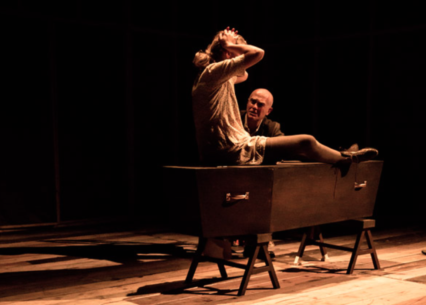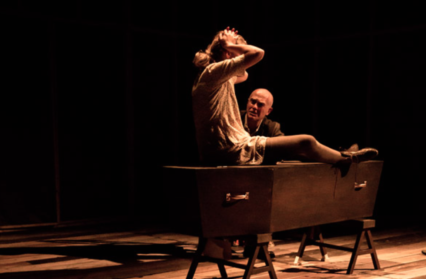Elin Williams reviews Rhwng Dau Fyd, a collaborative theatre project between Living Pictures, Theatr Genedlaethol and Sherman Cymru.
If a theatre experience can promise anything it’s a ‘feeling’ post performance. Whether the feeling is dislike, love or uncertainty, it all helps shape and form an opinion. After any performance, the initial reaction is built upon and given time to ferment. When the evening produces three completely different pieces however, although they may all be under the same umbrella theme, it can take more time to assess these opinions and consider what they mean.
Rhwng Dau Fyd was a collaborative project between three major Welsh companies: Living Pictures, Theatr Genedlaethol and Sherman Cymru. The project was a showcase for new, original writing and was also the culmination of a year’s training for emerging directors on the Living Pictures specialist scheme. Each company contributed a significant priority. Living Pictures’ priority was to support their emerging directors, whilst Sherman Cymru provided the space and stipulated structural conditions. Theatr Genedlaethol was concerned that the work had to be of a specific standard, and on top of all of this, the playwrights were also protective over their own pieces of new work. Considering all of this, the project was extremely ambitious. But did it work?

The writers were given the theme of ‘Blodeuwedd’ as a starting point, which seemed to imply that all pieces would have a common thread, thus ensuring a continued feel to the performances. Branwen Davies’ Gwagle was a playful piece based on the writer and process of creation. The piece was the perfect starting point of the evening. Daf is a troubled writer with a deadline looming. In his disgruntled state he wanders around his flat in his pants, imagining radio interviews where he is accused of being ‘boring’ and a ‘one trick pony’. With a little bit of inspiration coming from a woman and her pet rabbit, Daf begins to create a character, the perfect woman, Mari. Mari manifests as a character, and begins to help him on his script-composing journey. Played wonderfully by Ceri Murphy, Daf starts to lose control over his character. Mari starts to challenge him and forces him to take risks and change direction with the script. A really dynamic piece which would definitely have provided many challenges for emerging director Wyn Mason, Branwen Davies’ piece was an experiment that paid off. Gwagle was an interesting modern re-telling of the old tale, the creation of the perfect woman. By linking an old theme to the process of new scriptwriting, the piece was surely a comment on the challenges of new writing, and more significantly, Welsh writing.
From an emerging writer to an established writer, Meic Povey’s piece Man Gwyn Man Draw followed the failing relationship of Ceri and Glyn. Married and frustrated, the pair play out different fantasies, including dangerous ones, which gives an insight into their troubled marriage. Ceri wants a man who tells her he loves her, who tells her she looks nice. She wants Glyn’s brother, Gary. Glyn is constrained by Ceri’s high expectations. He will never be what she wants him to be; he will never be his brother. So he goes out and finds a red-headed barmaid instead. A completely absorbing and dangerously dark script by the top dog of Welsh drama, Man Gwyn Man Draw is the next step in the process after creation. The drama plays out the relationship between the perfect woman and the man who can’t give her what she wants. Ceri is Blodeuwedd who wants Gronw Pebr to murder her husband Lleu Llaw Gyffes, her sexuality ruling her morality. Povey’s piece explores the really intense, dark aspects of the Mabinogi story, but with his excellent skill and ability, manages to completely modernise it and create really layered characters. This was the most absorbing piece of the evening which kept the audience completely enthralled.
The last piece, written by the Caryl Lewis, told the story of Marjori, a medium who is forced to repress her ‘gift’ for fear the neighbours of the small village will brand her a demon of Hell. Although the piece was extremely well written and Heledd Gwynn gave an outstanding performance as the tortured Marjori, the script fell into the tedious conventions of a stock type drama. Inexplicably the piece was set in the 60s with no indication as to why the era was significant. The piece was a very standard three act drama condensed into thirty minutes. It didn’t raise any questions or challenge any conceptions; it didn’t really do anything. Although the story was captivating in parts, it just wasn’t clear why it was linked to the story of Blodeuwedd, hence why it stood apart from the other two pieces.
Cai Dyfan’s set provided numerous possibilities. A framework of an empty house, the set contributed to an eerie, other worldly feeling. The set changes were done mostly by the other actors involved, and these performance scene changes also helped with the intertwining of the three pieces and the sense of continuity. The evening was a celebration of talent, writing wise, acting wise and of course, directing wise. Rhwng Dau Fyd also brought the audience back to the conventional theatre for a change, as lately every effort seems to be put into site specific productions. Sometimes it’s nice to sit in the dark, watch a stage, and be completely absorbed into a piece. A really exciting collaborative project which sets a precedent for variety and the supporting of new work.
Elin Williams has written a number of reviews for Wales Arts Review.












